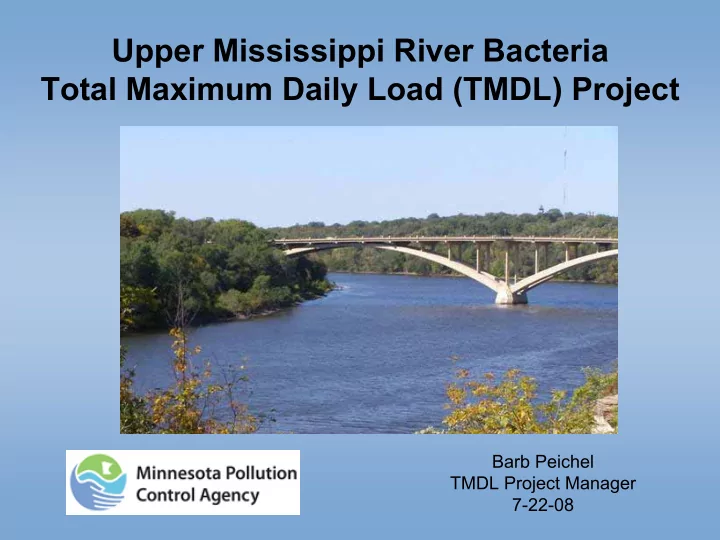

Upper Mississippi River Bacteria Total Maximum Daily Load (TMDL) Project Barb Peichel TMDL Project Manager 7-22-08
Outline 1. Minnesota’s Impaired Waters 2. TMDL Study Process 3. Upper Mississippi River Bacteria TMDL
Clean Water Act (1972) Goal - Restore and maintain the chemical, physical, and biological integrity of U.S. waters Section 303 of CWA 1. Assess state waters - meet water-quality standards? 2. List impaired waters - 303(d) List 3. Conduct TMDL studies - set pollutant reduction goals
Beneficial Use Classifications Use Class Beneficial Use Class 1 Drinking Water Class 2 Aquatic life and recreation 2A Cold water fisheries, trout waters 2Bd Cool and warm water fisheries, drinking water 2B Cool and warm water fisheries 2C Indigenous fish and associated aquatic community Wetlands 2D Class 3 Industrial uses and cooling Class 4A Agriculture and wildlife uses Class 5 Aesthetics and navigation Class 6 Other uses Class 7 Limited resource value waters
Examples of Impairment Biotic Integrity Bacteria Nutrients Turbidity
Numeric Standards Aquatic Recreation (1 o and 2 o body contact) Current Units New Units Notes Standard Standard (2008) Fecal 200 orgs E. coli 126 orgs Geometric mean of Coliform per 100 ml per 100 ml > 5 samples/month (April – October)
MN Impaired Waters 2008 Impaired Waters All impaired Impaired waters needing a TMDL 303(d) List waters 2,575 1,475 (510 Lakes, 336 Rivers)
Water Quality Pr otecting Improving List as Meets water Delisting Impaired quality Does not meet 303(d) standards water quality standards Protection TMDL Study Strategy Monitoring & Impaired Clean Development Assessment Waters Waters Develop pollution reduction plan Restoration Protection Activities Activities Protection & Restoration Tools
Outline 1. Minnesota’s Impaired Waters 2. TMDL Study Process 3. Upper Mississippi River Bacteria TMDL
Total Maximum Daily Load (TMDL) A TMDL Study - 1. Identifies pollutant sources 2. Determines pollution reduction needed to restore the water quality
Quantifying a TMDL Number Sum of the allowable loads of a single pollutant from all contributing permitted and non-permitted sources TMDL = Σ WLA + Σ LA + MOS + RC WLA = Wasteload Allocation, “permitted sources” LA = Load Allocation, “non-permitted sources” MOS = Margin of Safety, “uncertainties” RC = Reserve Capacity, “future growth”
TMDL Process Determine Sources Causing Impairment • Analyze existing data • Conduct additional monitoring Allocate Pollutant Loads • Use models/other tools - ID stresses/develop loads • Assign loads – permitted/non-permitted sources *Deliverable: TMDL Report Develop Implementation Strategies/Plan • Identify leads & partners • Create monitoring and evaluation plan *Deliverable: Implementation Plan
Bacteria Impairments Potential sources • Human, livestock, pet, and wildlife waste How does it get there? • Stormwater systems • Areas with field-applied manure fertilizer or storage • Non-compliant septic systems • Connected waterbodies • Wastewater treatment facilities • Feedlots
Potential Best Management Practices (Urban Areas) Stormwater Inspect/monitor outfalls, ID illicit discharges/connections Infiltrate/Filter - rain gardens, infiltration basins, sand filters Reduce Sediment Runoff - street sweeping Preserve/Restore Riparian Buffers “Hot spots” near waterways Pet Waste Evaluate ordinances, Create educational materials Wildlife ID wildlife populations, Wildlife feeding bans, Geese control
Outline 1. Minnesota’s Impaired Waters 2. TMDL Study Process 3. Upper Mississippi River Bacteria TMDL
Upper Mississippi River Bacteria TMDL Project Joint Effort of MDH & MPCA • Beneficial use designation • CWA/SDWA • MDH Source Water Protection/MPCA TMDL Overall Goal • Improve and restore the water quality of the Upper Mississippi River Project Objectives • Describe pollutant reduction and actions – how do we get Upper Mississippi River reaches to meet water quality standard ( E. coli ) • Develop a TMDL Report & Implementation Plan for at least five mainstem Mississippi River impaired (bacteria) reaches
TMDL Project Scope & Bacteria Impairments
Upper Mississippi River Bacteria TMDL Project Stakeholder Involvement • Stakeholder Advisory Team (SAT), Technical Advisory Committee (TAC), Policy Advisory Committee (PAC) • Roles & Responsibilities – Review documents, attend meetings, make recommendations, partner to conduct project tasks • Metro & St. Cloud based meetings • Annual Meetings
Bacteria Data Upper Mississippi River (07010206-509) Fecal Coliform Concentrations over Time 5000 4500 4000 3500 Fecal Colifom (orgs/100 ml) 3000 2500 2000 1500 1000 500 0 Oct-1995 Mar-1997 Jul-1998 Dec-1999 Apr-2001 Sep-2002 Jan-2004 May-2005 Oct-2006 Feb-2008
Bacteria Data Geometric Mean of Fecal Coliform (# orgs/100 ml) for the Mississippi River (reach 07010206-509) Month 1997 1998 1999 2000 2001 2002 2003 2004 2005 2006 13 April 34 May 37 119 162 68 June 59 94 212 July 251 173 75 217 214 August 62 111 139 45 Sept. 49 28 Oct.
For More Information • Final TMDLs (8/1) – Blue Earth River – Carver-Bevens-Silver Creeks – Chippewa River – Lower Mississippi River Basin – Pipestone Creek* – Pomme de Terre – Rock River – Sunrise River (North Branch) – Yellow Medicine (South Branch) • TMDL Bacteria Protocol & Fact Sheet • Guidance Manual - Assessing MN Surface Waters
For More Information www.pca.state.mn.us
For More Information www.pca.state.mn.us/water/tmdl/
Upper Mississippi River - Bacteria TMDL
Upper Mississippi River - Bacteria TMDL DRAFT Timeline Summer/Fall 2008 • Create Work Plan • Hold 1 st stakeholder meetings • Start summarizing existing data • Discuss CWA/SDWA 2009-2011 • Conduct additional monitoring • Identify pollution sources Photo: FMR 2011/2012 • Develop TMDL Report 2012/2013 • Develop Implementation Plan
Recommend
More recommend